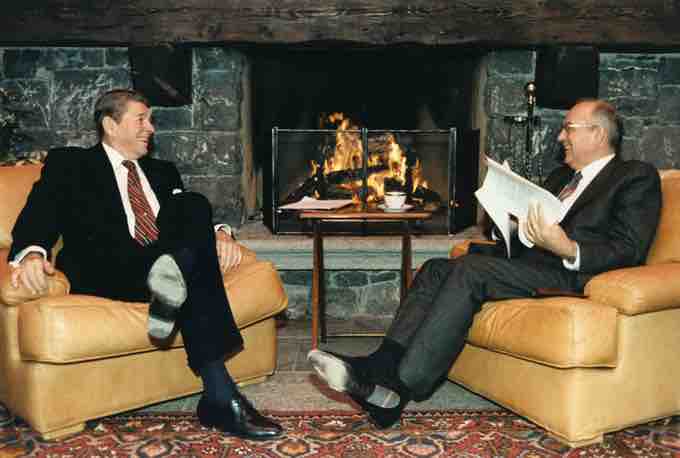The End of the Cold War
By the later years of the Cold War, Moscow had built a military that consumed as much as 25% of the Soviet Union's gross national product at the expense of consumer goods and investment in civilian sectors. However, the size of the Soviet armed forces was not necessarily the result of a simple action-reaction arms race with the United States. Instead, Soviet spending on the arms race and other Cold War commitments can be understood as both a cause and effect of the deep-seated structural problems in the Soviet system, which accumulated at least a decade of economic stagnation during the Brezhnev years. Soviet investment in the defense sector was not necessarily driven by military necessity but in large part by the interests of massive party and state bureaucracies dependent on the sector for their own power and privileges.
Restructuring the Soviet Union
The Soviet Union's large military expenses, in combination with collectivized agriculture and inefficient planned manufacturing, were a heavy burden for the Soviet economy. At the same time, Saudi Arabia increased oil production, which resulted in a drop of oil prices in 1985 to one-third of the previous level. (Petroleum exports made up around 60% of the Soviet Union's total export earnings.) By the time Mikhail Gorbachev had ascended to power in 1985, the Soviets suffered from an economic growth rate close to zero percent, combined with a sharp fall in hard currency earnings as a result of the downward slide in world oil prices.
To restructure the Soviet economy before it collapsed, Gorbachev announced an agenda of rapid reform based on what he called perestroika (restructuring) and glasnost (liberalization, openness). Reform required Gorbachev to redirect the country's resources from costly Cold War military commitments to more profitable areas in the civilian sector. As a result, Gorbachev offered major concessions to the United States on the levels of conventional forces, nuclear weapons, and policy in Eastern Europe.
Many U.S. administration officials doubted that Gorbachev was serious about winding down the arms race; however, President Reagan recognized the real change in the direction of the Soviet leadership and shifted to diplomacy to personally push Gorbachev further with his reforms. Reagan sincerely believed that if he could persuade the Soviets to simply look at the prosperous American economy, they too would embrace free market capitalism.
Reduction in the Arms Race
The East-West tensions that had reached intense new heights earlier in the decade rapidly subsided through the mid-to-late 1980s. Gorbachev and Reagan held four summit conferences between 1985 and 1988: the first in Geneva, Switzerland; the second in Reykjavík, Iceland; the third in Washington, D.C.; and the fourth in Moscow. On the third meeting, Gorbachev and Reagan signed the Intermediate-Range Nuclear Forces (INF) Treaty at the White House, which eliminated an entire class of nuclear weapons. The two leaders laid the framework for the Strategic Arms Reduction Treaty, or START I; Reagan insisted that the name of the treaty be changed from Strategic Arms Limitation Talks to Strategic Arms Reduction Talks.
In 1988, the Soviets officially declared that they would no longer intervene in the affairs of allied states in Eastern Europe. In 1989, Soviet forces withdrew from Afghanistan. In November 1989, the Berlin Wall was torn down, the Cold War was officially declared over at the Malta Summit on December 3, 1989, and—two years later—the Soviet Union collapsed.

Reagan and Gorbachev Hold Discussions
Reagan and Gorbachev built a close relationship and contributed greatly to the peaceful end of the Cold War